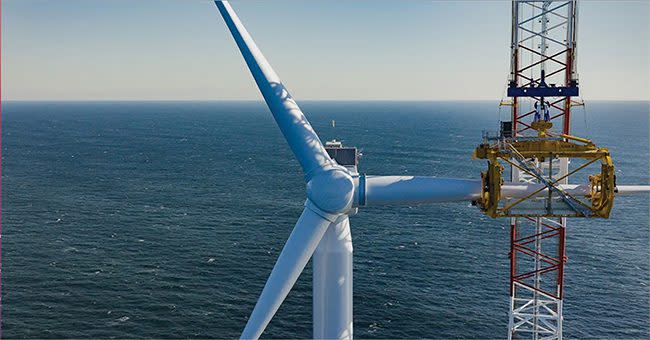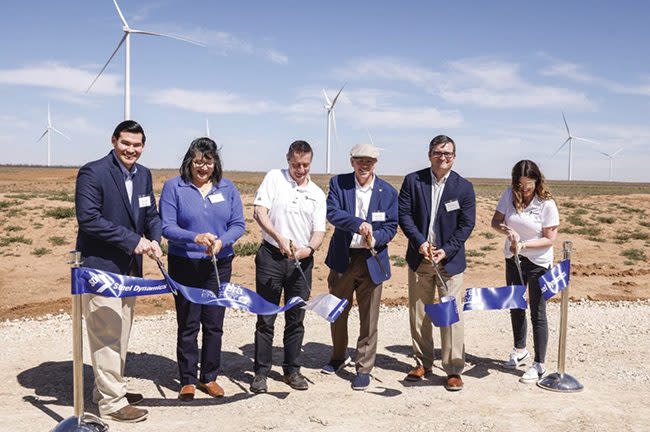Measuring the Prospects for Wind Energy in 2024 and Beyond
The wind energy industry has been on an exponential growth curve for more than a decade. POWER looks at the drivers behind the growth and predictions for the future. Nearly 200 countries made major collective pledges on energy at the United Nations climate summit (COP28) in Dubai last December. Many governments recognized that to achieve the goal of limiting global warming to 1.5C, energy-related emissions need to reach net zero by 2050. As such, they set key goals, which included, among other things, the tripling of global renewable energy capacity by 2030. Assuming targets are applied to all renewable energy sources equally, that means global wind power capacity must reach about 3 TW by the end of the decade. Is that really possible?
2023 Was a Record Year
According to the Global Wind Energy Council’s (GWEC’s) Global Wind Report 2024, last year saw the highest number of new onshore wind power installations in history—more than 100 GW—and it was the second-highest for offshore wind (11 GW). Meanwhile, the symbolic milestone of 1 TW of total installed global wind power capacity was passed. GWEC says at the current rate it expects the world to hit 2 TW before 2030, but that isn’t the goal that was set during COP28. “We must acknowledge, firstly, that this rate of growth still leaves us far short of the tripling target,” Jonathan Cole, CEO of Corio Generation and chair of GWEC, wrote in the report’s Foreword. Cole said global inflationary pressures, rising cost of capital, and fragility in the supply chain affected the industry’s ability to ramp up construction in many regions. Still, the year-over-year growth in wind energy installations was astounding—greater than 50%. Remarkably, that growth was achieved while the industry navigated several other obstacles beyond the issues Cole mentioned. “Despite the world being fully open following the global health crisis sparked by COVID-19, 2023 remained an unusual year due to the challenging macroeconomic environment, rising and ongoing hostilities, the Red Sea crisis and prolonged supply chain disruptions stemming back to the time of Russia’s invasion of Ukraine,” Feng Zhao, GWEC’s head of Strategy and Market Intelligence, wrote in the report’s Executive Summary. “Connecting 117 GW of wind power capacity to the electricity grid in a single year not only demonstrates the remarkable resilience and adaptability of the wind industry but also shows that the world is moving in the right direction in combating climate change,” he added. China, which set a record by commissioning more than 69 GW of new onshore wind installations, was the world’s largest market in 2023, followed by the U.S., Brazil, Germany, and India. Together, the top five markets made up 82% of global new installations last year.
A Slowdown in America
Yet, while U.S. installations may rank highly compared to other countries, the numbers were disappointing to many industry insiders, and the sluggishness has continued this year. The American Clean Power Association (ACP) released its most-recent Clean Power Quarterly Market Report on May 7, covering the first quarter (Q1) of 2024. The report says, “Land-based wind had a lackluster quarter, with just two land-based wind projects commissioned.” The two projects, both located in wind-rich Texas, brought a total of 449 MW of new land-based wind capacity online in Q1 2024 (Figure 1).
 |
1. NextEra Energy Resources completed the Canyon Wind Energy Center located in Scurry County, Texas, during the 1st quarter 2024. Courtesy: NextEra Energy Resources |
First-quarter installations decreased by 68% year-over-year in the U.S. It was the slowest first quarter the wind industry had experienced since 2018. Additionally, land-based wind installations decreased 90% compared to the previous quarter. ACP blamed the slowdown on “issues with the supply chain, siting, and permitting, as well as long wait times in the interconnection queue. All of which contributed to lower overall project deployments.” Meanwhile, ACP touted Q1 2024 as the best quarter on record for U.S. offshore wind installations, with the 132-MW South Fork Wind project added to the grid. Enthusiasm should be tempered, however, as only 42 MW of offshore wind had ever been commissioned in the U.S. prior to that. The earlier projects were the 30-MW Block Island wind farm, which entered commercial operation in December 2016 and won a POWER Top Plant award the following year, and the 12-MW Coastal Virginia Offshore Wind pilot project, which has been fully operational since fall 2020. South Fork Wind was a joint offshore wind project by Ørsted and Eversource. The project consists of 12 Siemens Gamesa Renewable Energy 11-MW SG 11-200 model wind turbines (Figure 2). It was constructed off the coast of Long Island, New York, and supplies power to the Long Island Power Authority through a 20-year power purchase contract. Offshore construction operations began in March 2023 and the project began producing electricity in December last year.
 |
2. The South Fork Wind project consists of 12 turbines off the coast of Long Island, New York. Courtesy: Ørsted |
Wind Energy Pipeline Projections
GWEC’s Feng Zhao suggested that the wind industry has become more optimistic about both short-term and long-term growth as a result of the COP28 tripling goal. “With a favourable political environment across the globe, GWEC Market Intelligence believes that 791 GW of new capacity is likely to be added in the next five years under current policies. This equals 158 GW of new installations each year until 2028,” he wrote. The five drivers Feng Zhao sees supporting this growth are:
GWEC predicts the compound annual growth rate (CAGR) for onshore wind will be 6.6% over the next five years, with growth in China, Europe, and the U.S. remaining the backbone of global onshore wind development. The expected CAGR for offshore wind, however, is markedly higher—28% in the next five years. China and Europe are expected to continue dominating the offshore market through 2025, but the U.S. and emerging markets in the Asia Pacific region will start gaining sizable market share from 2026 onward, according to GWEC. ACP reported the land-based wind pipeline in the U.S. totaled about 25.3 GW at the end of Q1 2024, up more than 5 GW from the same time last year. Onshore wind under construction increased by 3.7 GW year over year, while the volume that met ACP’s definition of advanced development increased by 1.3 GW. The U.S. offshore wind sector had 22.9 GW in the pipeline at the end of Q1 2024, according to ACP. However, ACP noted that the data was compiled prior to New York’s cancellation of its third solicitation in April. The three projects canceled in New York were the 1,404-MW Attentive Energy One, the 1,314-MW Community Offshore Wind, and the 1,314-MW Excelsior Wind, which would presumably decrease the U.S. pipeline by roughly 4 GW.
Burgeoning Concerns
Meanwhile, potential supply chain issues could hold the industry back. Findings from a Baringa report released in April bring to light several worrisome constraints. While Baringa’s research was conducted on behalf of the UK’s Department for Energy Security and Net Zero, the findings apply to markets around the world. “The U.S. recently announced ambitious targets of 30 GW of offshore wind by 2030 and 110 GW by 2050,” Rob Gilbert, partner at Baringa, told POWER. “These targets are widely seen as unrealistic.” Gilbert said the equipment required to achieve such targets is significant, and given the nascency of the offshore wind industry in the states, there is a lack of manufacturing capacity to produce these components on home soil. “The majority of components will need to be imported,” he said. “For example, we anticipate that between now and 2030, more than 1,000 wind turbines—more than 50% of expected installations—will need to be imported. This is a challenge considering the already overburdened European Union and UK supply chains.” To emphasize his point, Gilbert noted that several new wind-related factories announced in the U.S. have been delayed, stalled, or canceled. “Siemens Gamesa canceled plans to build a blade factory in Portsmouth, Virginia. GE Vernova and LM Wind Power lost out on $300 million of grant funding tied to the New York state round three wind solicitation after it was canceled. A Marmen and Welcon tower facility has been delayed due to skyrocketing supply chain costs. And Vestas lacks the certainty to commit to new factories in New York and New Jersey,” said Gilbert. All of these setbacks could slow future wind projects in the U.S. The Baringa report notes that an initial surplus of key turbine components today is projected to become a minor shortfall in blades and nacelles, and a significant shortfall in towers, from 2025 to 2028 due to increased demand, with intermittent minor shortfalls thereafter despite the opening of new factories. The consultancy’s modeling projects a severe shortfall of monopiles used for fixed-bottom foundations through 2026, although it expects those constraints to improve in 2027. A severe shortfall of high-voltage direct-current export cables is expected to ease starting next year, but remain persistent through 2032. Lastly, despite an initial surplus of small turbine and foundation vessels, Baringa’s analysis shows a significant shortfall of Category 2 (12 MW to 15 MW) and Category 3 (greater than 15 MW) turbine installation vessels through 2026, with severe shortfalls for Category 2 and 3 foundation vessels through 2029, and a severe shortage of vessels equipped to install cables through 2032.
—Aaron Larson is POWER’s executive editor.

 Yahoo Finance
Yahoo Finance 

